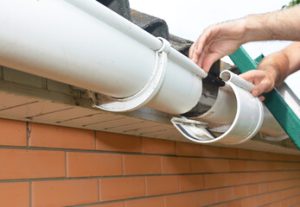Gutters are an often-overlooked home component that protects the integrity of your home from water damage. However, gutters can only do their job properly if they are well-installed and maintained.

Proper gutter installation requires precision and attention to detail, involving a complete system of gutters, downspout outlets, and extensions that work together to channel water effectively.
Gutter systems are an essential component of a home’s roof, protecting it from water damage and the need for expensive repairs. However, gutters require careful installation to function properly. Professionals have the experience to handle the task quickly and effectively, saving homeowners from time and money.
Gutters are constructed from metal or plastic and positioned on the lower edge of a house to absorb and drain rainwater. They’re often placed in areas with steep slopes or hills for increased drainage. Gutter systems can also be installed with downspouts to channel water away from the foundation of a building, helping prevent soil erosion and flooding.
When a gutter system is improperly installed, it can lead to serious problems throughout the building, including foundation failure, damp basements, mold growth and sagging walls. A professional installer will ensure that the gutters are positioned correctly and that they have the right slope to drain water properly.
A gutter system consists of a series of sections that are connected to each other by connectors and downspout outlets. It is essential that the connectors and outlets are matched to the gutter materials for optimal performance. For example, copper gutter systems should have copper downspout outlets, while aluminum gutter systems should use aluminum downspouts.
The installation of gutters is a process that begins by measuring the length of each roofline to determine the number and location of gutter sections. Once the measurements have been taken, the gutter pieces are cut to size using tin snips or a power saw equipped with a metal-cutting blade. Once the pieces have been cut, they are fitted into brackets attached to the roof’s fascia board. The gutters should be spaced at least 3 feet apart to provide adequate support, but closer spacing may be necessary in areas prone to heavy rainfall or snow loads.
Once the gutters are installed, they should be hung and secured to the fascia boards using gutter screws and gutter-rated sealant. Downspout outlets should be installed every few feet and routed several feet away from the foundation to avoid clogging, overflow, or flooding.
Removal
If gutters aren’t removed properly, they can cause leaks and structural damage to your home. This is particularly true if the old gutters are still attached to the fascia boards, which can cause paint to peel and deteriorate over time.
Gutters are installed at the end of roof shingles and channel rainwater into downspouts, where it’s safely directed away from your home. Without a proper guttering system, water can seep under the roofline and through the sides of the house, which can lead to mildew, mold, and wood rot. Gutters also help to prevent foundation cracks.
One of the most important steps in a gutter installation is taking precise measurements of the roof area. This will allow the roofing specialist to accurately construct the future gutters, including any necessary corners, and make sure that downspout outlets are in the best locations to direct water away from your home’s foundation.
Once the measurements are completed, the new gutters can be cut to size and nailed or screwed into place. It’s a good idea to use galvanized screws when working with aluminum gutters, as these are more durable and won’t rust. Once the gutters are secured, the roofing contractor will install the downspout outlets and elbows. The downspout outlets are usually placed at the lowest points of the gutter slope, and they are designed to direct water safely away from your home.
The elbows are used to ensure that the downspouts stay secure in the gutters and that water flows through them smoothly. Once the gutters are complete, they will be tested during a heavy rainstorm to ensure that they’re functioning correctly.
Depending on the condition of the old gutters, this step can take a few days. However, it’s essential to get this part of the job right, as the new gutters will be in place to protect your home from foundation issues and other structural problems for years to come. Getting this step right the first time will save you money in the long run by preventing unnecessary repairs and replacements of your gutter system.
Replacement
The proper slope of gutters helps to direct water from the roof and away from the foundation of the home, protecting the structure from damage. Insufficient or faulty gutters can lead to a range of problems, from leaks in the roof to overflowing down the sides of the house and even flooding basements. Gutters are crucial for preserving the structural integrity of a home, reducing repair costs and saving homeowners money in the long run.
If you’re in need of new gutters, consider hiring a professional contractor to ensure that the installation is done correctly. The right professionals can efficiently navigate complex roof structures and difficult weather conditions. Their expertise can prevent future costly repairs and save you time, money and headaches down the road.
Choosing the right material for your gutter system is an important factor in determining the final cost. Copper channels and steel networks are high-end investments, offering superior longevity over budget options. These premium materials also add distinctive architectural statements to the home’s exterior. However, the price tag is higher for these options.
It’s essential to have a reliable way to measure the length of your roof and gutters before purchasing any materials. A variety of tools exist to assist with this process, including gutter and roof rakes and digital software programs like GutterScope and RoofScope+. The latter is a more advanced tool that uses high-resolution aerial images to return precise roof and gutter measurements, which significantly streamlines the process.
After you’ve selected the gutter size and style that meets your needs, it’s time to start installing them! First, assemble the gutter sections by connecting them with hangers or brackets. Then, use a drill and corrosion-resistant screws to secure each bracket along the roofline. Be sure to align each bracket with the slope that you’ve marked earlier. Lastly, install downspout outlets at the lowest points of the gutter slope to help direct water away from your home’s foundation and preventing floods and pooling.
It’s essential to keep in mind that gutter systems require regular cleaning and maintenance to function properly. Skilled contractors like Mighty Dog Roofing provide comprehensive assessments that detail all the components of a gutter system and ensure optimal value. Regular maintenance extends the lifespan of gutters by 10-15 years, minimizing replacement and repair costs over the long-term.
Maintenance
While gutters protect roofs from water damage, they need to be regularly inspected and properly maintained to perform their job. Gutters that are clogged with leaves, twigs, or debris impede the flow of rainwater and can lead to the development of structural problems such as sagging, leaks, and rust. Professionals like M&E Painting and Roofing offer gutter maintenance to ensure that they function properly and avoid costly repairs.
The first step in the process of installing a new gutter system is to measure the length of your roof edge and determine the square footage. This will help you choose the right size gutters and determine how many downspouts are needed to accommodate your roof’s water drainage needs. Then, begin installing the gutter brackets along your roof’s fascia board. Make sure each bracket is firmly secured to the board and is aligned with the slope you marked earlier to maintain efficient water flow.
Once the gutters and downspouts are installed, seal all seams and connections with a high-quality waterproof sealant. Then test the system by running a hose over it. Water should flow through the system without ponding or spilling over the edges, and downspouts must be positioned far enough away from the foundation to avoid major structural damage.
Regular gutter cleaning is essential for maintaining your gutter system, especially in the fall and spring when the gutters are most likely to get clogged. Check for signs of sagging, rust, or leaks and address any issues promptly by applying additional sealant or re-securing loose sections. It’s also a good idea to inspect the system after severe weather events such as high winds, large snowfalls, or long periods of continuous rains.
If your gutters are beyond repair or if you’re in the market for a replacement, contact PJ Fitzpatrick to discuss your options. Their experienced crew can assess the condition of your existing gutters to make informed recommendations for repairs or replacement. Then, they’ll work with you to schedule a convenient time for installation that fits your schedule and budget. Open communication with the team will ensure that you understand the timeline and can expect the gutter installation process to be as efficient as possible.



